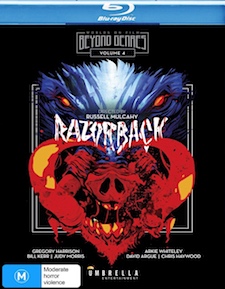Razorback (Blu-ray Review)

Director
Russell MulcahyRelease Date(s)
1984 (August 10, 2018)Studio(s)
Greater Union Film Distributors/Warner Bros. (Umbrella Entertainment)- Film/Program Grade: B-
- Video Grade: A-
- Audio Grade: B+
- Extras Grade: A-
Review
[Editor’s Note: This is a Region Free release.]
Constantly compared to Jaws throughout its theatrical run and later on in its aftermarket life, Razorback has always been more of a calling card for the talents of Russell Mulcahy, who had directed music videos up to that point but would go on to make what most genre fans would later know him best for: Highlander. But before that, Razorback would toss conventions aside, going for a more artistic approach to its material, but also throwing critics and audiences a curve ball who were expecting nothing more than a simple monster movie... and Razorback is nothing of the sort.
Razorback follows an investigative reporter (Judy Morris) into the Australian outback as she follows up on rumors of the illegal hunting and processing of the local wildlife. Soon, she finds herself on the run from two of the locals (Chris Haywood and David Argue) and is attacked, but is later killed by a giant killer boar, essentially freeing the locals of any wrongdoing. Her husband (Gregory Harrison) soon comes to investigate what happened to her with the help of a revenge-obsessed older man (Bill Kerr) and a wildlife observer (Arkie Whiteley), but they soon find themselves out of their depth as both the two locals and the giant boar are out to kill them.
Russell Mulcahy’s visual style for the film, which includes frequent shaking of the actual frame, extreme snap zooms, unorthodox camera angles, and a constant use of bold colors and lighting schemes, made what could have been a rather perfunctory story into a visual feast. Never one to stick to storyboards for inspiration, he was always thinking on the spot and finding new ways to film each scene, either through discussions with his cinematographer (Dean Semler) or by pure accident. To be completely honest, the story for the film isn’t all that great, but what gets you through it is the intensity of it and the way it was shot. Mulcahy was also smart enough to show the boar as little as possible, leaving more to the imagination. And while Razorback’s plot tends be a mixed bag, no genre film before it could match its unconventional but entertaining use of the frame.
Umbrella Entertainment’s Worlds on Film: Beyond Genres – Vol. 4 release of Razorback (a re-release of an earlier Blu-ray) features a new 4K-sourced presentation of the film, complete with more information along the edges of the frame, higher levels of detail, and a different color palette. Hues are aggressively bolder in areas, particularly when it comes to blues, reds, and browns, with flesh tones taking on a warmer look, which feels entirely appropriate to the dry and sun-soaked desert landscape. Blacks are much deeper, perhaps even with a bit of crush to them, while the overall image is bright with high contrast. The image appears quite natural with solid grain levels, a stable frame, and an overall lack of leftover damage. The only thing that would have made it better would have been a slightly higher encode, which normally hovers between 27.0 to 30.0 kbps. For the audio, a new English 5.1 DTS-HD mix is included with optional subtitles in English SDH. It would have been nice to have had the original mono soundtrack as an option as well, but the 5.1 track is quite aggressive and suits the film well. Sounds are placed all over the surrounds with frequent panning and background activity. Dialogue is mostly clean and clear with good separation for sound effects and score. Low end activity is also frequent, particularly from the score and the sounds of the boar. It still has its dated weaknesses, but overall, it’s a pleasant sonic upgrade that does much more than your average 5.1 remix.
For the extras, it’s a blend of new and old material. Included is a new audio commentary with director Russell Mulcahy and writer Shayne Armstrong, which isn’t overly energetic but goes into several areas of interest; a 31-minute audio interview with actor Gregory Harrison; Jaws on Trotters: The Making of Razorback, a 74-minute documentary which features several members of the key cast and crew; 90 minutes of interviews from 2013 by Mark Hartley for the Not Quite Hollywood documentary, including bits from Gregory Harrison, actress Judy Morris, Russell Mulcahy, writer Everett De Roche, producer Hal McElroy, and special make-up effects technician and “Razorback” creator Bob McCarron; 2 1/2 minutes of “grisly” deleted scenes with optional audio commentary by Mulcahy and Armstrong; the Australian VHS version of the film, which is presented full frame and leaves the aforementioned “grisly” scenes intact; the Australian theatrical and VHS trailers for the film; A Certain Piggish Nature: Looking Back at Razorback, a 24-minute roundtable discussion with film critics Alexandra Heller-Nicholas, Lee Gambin, Sally Christie, and Emma Westwood; and last but not least, an image gallery containing 109 images from the film’s marketing campaign, newspaper ads, magazines, behind the scenes stills, and on-set photography. Also included is an Easter egg that can be found by pressing left when “VHS Trailer” is highlighted in the “Special Features” menu, which will take you to a commercial for the film’s Australian TV premiere.
Razorback is a surprisingly better than average thriller about a giant boar tearing through the Australian outback and slaughtering everything it comes into contact with. Umbrella’s Worlds on Film: Beyond Genres line gives the film a much-need spit and polish with a boatload of extras and a fine high definition presentation. If you’re a fan of the film, this one’s a no-brainer. Highly recommended!
- Tim Salmons
(You can follow Tim on social media at these links: Twitter and Facebook. And be sure to subscribe to his YouTube channel here.)

